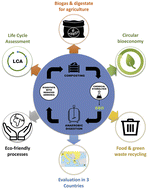Integrated chemical and biochemical technology to produce biogas with a reduced ammonia content from municipal biowaste. Validating lab-scale research in a real operational environment†
Abstract
The current paper reports the scientific, technical, environmental, economic and social impacts of two integrated chemical and biochemical processes that employed a novel virtuous biowaste cycle under real operational conditions of three industrial sites in Italy, Greece and Cyprus. The work was based on previous laboratory research pertinent to the valorisation of municipal biowastes (MBWs) as a feedstock to obtain value added soluble biobased (SBO) products. The research pointed out that the site-specific nature of MBW was the main criticality, which could potentially hinder the industrialisation of the MBW-SBO paradigm. The present work demonstrates the feasibility of a new scenario for a conventional waste treatment plan collecting and processing MBWs by anaerobic and aerobic fermentation. In essence, the virtuous biowaste cycle is realised by producing SBO from the plant MBW (process 1) and recirculating it to the MBW feed of the anaerobic fermentation reactor to reduce the ammonia content in the digestate (process 2). This mitigates the digestate's environmental impact. Life cycle sustainability assessment demonstrates that the use of SBO produced from local MBW allowed reducing the ammonia content of the digestate generated from the local anaerobic fermentation facilities in the three different countries by 21–68% as well its eutrophication potential. Process 2 allowed at least 86% OPEX cost saving compared to conventional digestate post-treatment technologies for ammonia abatement, while paying off the CAPEX cost in less than one year. Socio-economic analysis evaluated the impacts on workers and local community stakeholders, potentially stemming from the implementation of processes 1 and 2 at European level. The analysis of SBO composition and performances in each operational site investigated showed that improved performance of process 2 might be achieved by isolating the active principles in raw SBO prior to their use in process 2. Chemical and biochemical catalysis by SBO active principles in process 2 support the specific perspective.

- This article is part of the themed collection: Topic Collection: Wastewater Treatment


 Please wait while we load your content...
Please wait while we load your content...